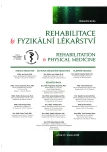-
Medical journals
- Career
Impedance Therapy in Rehabilitation of Degenerative Disease of the Spine
Authors: P. Kostka 1; E. Žiaková 2
Authors‘ workplace: Klinika Impedančej terapie, Bratislava 1; Katedra fyzioterapie, Inštitút fyzioterapie, balneológie a liečebnej rehabilitácie, Univerzita sv. Cyrila a Metoda v Trnave 2
Published in: Rehabil. fyz. Lék., 27, 2020, No. 1, pp. 22-29.
Category: Original Papers
Overview
Impedance therapy offer new procedures in the therapy of degenerative changes of the spine by objective control of structural and degenerative changes. The paper investigated the influence of an innovative Impedance therapy (IT) on changes in the health state in the rehabilitation care of patients suffering from degenerative disease of the spine (DDD). The authors verified the influence of IT in the therapy of degenerative disease of the spine by confirming the “Disc grow up“ (DGU) phenomenon. The cohort in the clinically randomized study (RCT) was formed by 55 patients at the average age of 51.3 years. The cohort was divided in two groups. The observed group of patients underwent rehabilitation with IT by a specific electric impulse (SEI) and the second (control) group underwent the same rehabilitation plan, while, instead of SEI, a classical electrotherapy constituted of 10 therapies which were applied in cycles which were repeated during the whole rehabilitation plan. In the observed group of patients (DDD), who were applied IT, the DGU phenomenon was observed with 76% successfulness, with statistically significant I crease od intervertebral discs. In the control group of patients, who underwent the standard electrotherapy, the DGU phenomenon was not observed. Based on the observed influence of the method of impedance therapy on the changes of intervertebral disc volume, the degenerative disease of the spine may be considered curable as a civilization disease.
Keywords:
impedance therapy – IT – specific electric impulse – DGU phenomenon – degenerative disease of the spine
Sources
1. DEYO, R. A. et al.: Back pain prevalence and visit rates: estimates from U.S. national surveys, 2002. Spine (Phila Pa 1976) 2006; 31 : 2724–2727.
2. JENSEN, M. P. et al.: „The subjective experience of acute pain. An assessment of the utility of 10 indices“. Clin. J. Pain. (June 1989) 5, 2. s. 53-59. doi:10.1097/00002508-198906000-00005. PMID 2520397
3. KOSTKA, P.: Impedančná terapia. 2017, 180 s. ISBN 978-80-89613-17-3
4. KOSTKA, P. et al.: Impedančná terapia II - aplikácia v medicínskej praxi. 2019, 204 s. ISBN 978-80-89613-24-3.
5. MARTIN, B. I. et al.: Expenditures and health status among adults with back and neck problems. JAMA 2008; 299 : 656–664.
6. MCCULLOCH, J. A., YOUNG, P. H.: Essentials of spinal microsurgery.
7. PAULO H. J. et al.: 2014:InVesalius: Software Livre de Imagens M´edicas www.researchgate.net/publication/260322057_InVesalius_Software_Livre_de_ Imagens_Medics Philadelphia, Lippincott-Raven 1998
8. RUBIN, D. I.: 2007 Epidemiology and risk factors for spine pain. Neurol Clin. 2007;25(2):353–371
9. WHEELER, A. H.: (Feb 03. 2016) Low Back Pain and Sciatica. eMedicine [on line]. In: Berman, S.A. Medscape, (cit 20.12.2016), dostupne na internete: http://emedicine.medscape.com/article/1144130-overview#a3
10. WMA. 2000. WMA Declaration of Helsinki – Ethical Principles for Medical Research Involving Human Subjects, WMA. In 52nd WMA General Assembly, Edinburgh, Scotland, October 2000. [cit. 2017-01-15]. Dostupné na internete: www.samawomenshealth.in/wma-declaration-of-helsinki-ethical-principleshttp://www.samawomenshealth.in/wma-declaration-of-helsinki-ethical-principles-for-medical-research-involving-human-subjects/for-medical-research-involving-human-subjects/
Labels
Physiotherapist, university degree Rehabilitation Sports medicine
Article was published inRehabilitation & Physical Medicine

2020 Issue 1-
All articles in this issue
- The Influence of an Oncological Disease of the Tactile System in Children
- Possibilities of Biomechanical Analysis of Spontaneous Locomotor Activity in Newborn Children
- Impact of High and Moderate Intensity of Physical Activity on the Prevalence of Stress Urinary Incontinence in Sportswomen
- Impedance Therapy in Rehabilitation of Degenerative Disease of the Spine
- The Use of Cognitive Dual Tasks in Evaluating the Level of Postural Control
- Influence of Lymphatic Drainage on the Fracture of Ankle Joint Solved by Osteosynthesis
- Effect of Prosthesis on Body Posture and Postural Stability in Upper Limb Amputees
- Occupational Intervention with Tobii PCEye Plus Eye Navigation for Clients with Pervasive Developmental Disorder
- Zdeněk Třískala, Dobroslava Jandová a kolektiv: Medicína přírodních léčivých zdrojů Minerální vody
- Rehabilitation & Physical Medicine
- Journal archive
- Current issue
- Online only
- About the journal
Most read in this issue- Impedance Therapy in Rehabilitation of Degenerative Disease of the Spine
- Influence of Lymphatic Drainage on the Fracture of Ankle Joint Solved by Osteosynthesis
- The Use of Cognitive Dual Tasks in Evaluating the Level of Postural Control
- Effect of Prosthesis on Body Posture and Postural Stability in Upper Limb Amputees
Login#ADS_BOTTOM_SCRIPTS#Forgotten passwordEnter the email address that you registered with. We will send you instructions on how to set a new password.
- Career

